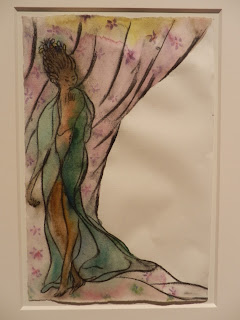To the National Gallery to see this huge tapestry - The Caged Bird's Song - a collaboration between artist Chris Ofili, and the weaving skills of Dovecot Tapestry Studio. The tapestry a triptych, over 5 metres long, took two and a half years to complete, and was commissioned by The Clothworkers' Company - a London livery company with a history that dates back five hundred years. The Clothworkers' Company will be the tapestry's permanent home when the exhibition finishes.
The tapestry's imagery reflects Ofili's interest in classical mythology, and contemporary 'demigods', together with the landscape of Trinidad his adopted home. The title of the tapestry refers to the first volume of Maya Angelou's autobiography, and the practice among Trinidadian men of carry around caged songbirds. Apparently Ofili was reluctant to accept the commission, and initially turned it down. He eventually agreed to take it on, but I'm not sure how comfortable he was with the project as some of the preparatory sketches do seem slight, or a little restrained in comparison to his earlier works.
The first room of the exhibition features those preparatory sketches, alongside the finished design. It's interesting to see the inclusion of footballer Mario Balotelli as a mythical God/cocktail waiter at the top of the composition, who seems to be the source of the waterfall in the tapestry. It looks as though Ofili watered down certain elements of the final tapestry, or had a change of heart, as the couple in the central panel seemingly engaged in a certain lovemaking position in the preparatory sketches, look to have been censured in the final tapestry. (Pictures 6, and 18 below).
The final largest room features the completed tapestry, the colours of which really glow in contrast to the background frieze designs of grey exotic (transgender?), female figures - some bearded and moustachioed - who pose and preen quite suggestively. These larger than life ladies were painted directly onto the walls of the National Gallery's Sunley Room by the Royal Opera House's scenic painters.
The tapestry itself is a triumph, and an impressive display of the Dovecot Tapestry Studio's weaver's art. The commitment of the weavers to this project I think enhances the original Ofili watercolour design by heightening the colour, and exaggerating the lovely bleeds, and wet-in-wet effects of his watercolour technique. They have caught, and interpreted Ofili's original sketch sensitively and beautifully.
Chris Ofili: Weaving Magic
until 28th August
National Gallery
Trafalgar Square
London



























